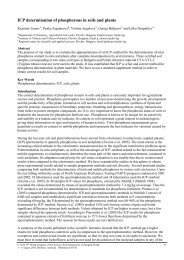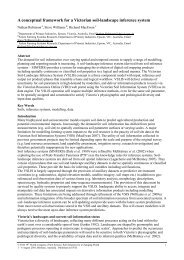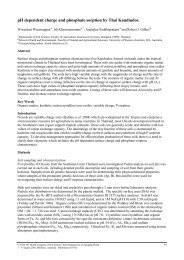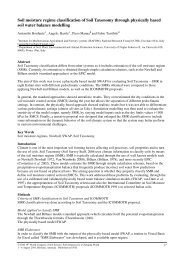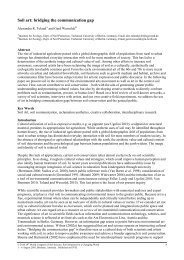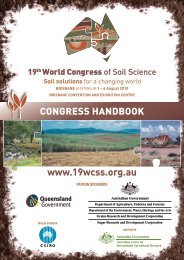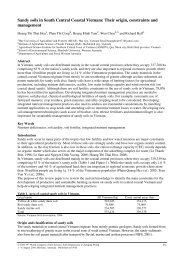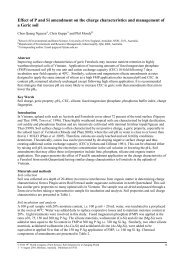Jiang Xianjun
Jiang Xianjun
Jiang Xianjun
You also want an ePaper? Increase the reach of your titles
YUMPU automatically turns print PDFs into web optimized ePapers that Google loves.
Long-term tillage effects on bacterial biomass and community structure<br />
distribution within water stable aggregates<br />
X.J. <strong>Jiang</strong> A<br />
A College of Resources and Environment, Southwest University, 2 Tiansheng Road, Beibei, Chongqing, 400715, China, Email<br />
jiangxj@swu.edu.cn<br />
Abstract<br />
This study addresses the tillage effect on the distribution of bacterial biomass and their community structure<br />
in a subtropical purple rice soil ecosystem. Similar distribution patterns of soil bacterial biomass within<br />
water-stable aggregates (WSA) were observed under different tillage managements. Although the<br />
distribution pattern of soil microbial biomass was not changed by tillage practice, soil microbial biomass<br />
increased significantly in all size fractions of WSA under combined ridge with no-till (RNT) treatment.<br />
While tillage management did not change the distribution patterns of soil microbial biomass, it did change<br />
their community structure. Results indicated that the distribution pattern of microbial biomass in WSA was<br />
governed by aggregate size, whereas bacterial community structure was significantly affected by tillage<br />
management.<br />
Key Words<br />
Soil structure, no-tillage, microbial community.<br />
Introduction<br />
Agricultural land management is one of the most significant anthropogenic activities that greatly alter soil<br />
characteristics, including physical, chemical, and biological properties and processes. Thus, while agriculture<br />
is expected to affect the diversity and structure of soil microbial communities, the specific responses of<br />
various bacterial groups to the changing environment in agricultural soils are not well understood (Buckley<br />
and Schmidt 2001). The aim of the present study was to evaluate how soil bacterial biomass and their<br />
diversity varies with soil aggregation under different tillage management in a sub-tropical purple rice soil.<br />
Material and methods<br />
Experimental site<br />
The Sichuan Basin is located in southwestern China (latitude 28-32° N, longitude 103-108° E) with an<br />
annual mean temperature of 14-19 o C, and rainfall of 1000-1400 mm. Field experiment has been carried out<br />
at Southwest University since 1990. The soil was Gleyi-stagnic Anthrosols. Crops: Rape (Brassica napus L.)<br />
in winter and rice (Oryza sativa L.) in summer.<br />
Tillage treatments and soil sample<br />
Combines Ridge with no-tillage (RNT): No-till treatment was imposed on the soil that was ridge tilled before<br />
the experiment, and the ridges were kept intact from 1989. Crops: Rice + Rape rotation in a year.<br />
Conventional Tillage (CT): Rice + Rape rotation in a year. Flooded Paddy Field (FPF): Rice was planted in a<br />
flooded field in summer and land remains fallow in winter. Water was kept flooded in the field all year.<br />
Surface soil samples (0-15 cm) were collected in April, 2008. Samples were stored at 4 o C for analysis.<br />
Fractionation of soil aggregates was achieved using a wet-sieving procedure (Elliott and Cambardella 1991;<br />
Cambardella and Elliott 1994).<br />
Microbial biomass assay<br />
Soil bacterial biomass content was calculated from muramic acid content according to Appuhn et al. (2004).<br />
A direct and an indirect method were used (Tsaiand Olsen, 1991) followed by purification steps (Smallaet al.<br />
1993) with slight modifications. The 16S rRNA genes from soil microbial communities were amplified by<br />
PCR by using the primer pair F984CC/R1378 described by Heuer et al. (1999).<br />
Data analysis<br />
All analyses were carried out on the four replicates. Data (measured or calculated) were subjected to<br />
ANOVA.<br />
© 2010 19 th World Congress of Soil Science, Soil Solutions for a Changing World 90<br />
1 – 6 August 2010, Brisbane, Australia. Published on DVD.
Result<br />
Distribution pattern of bacterial biomass within soil WSA under different tillage managements<br />
The distribution pattern of bacterial biomass under CT, RNT, and FPF had a similar trend. Except for the<br />
macro-aggregates bigger than 4.76mm, in which bacterial biomass under CT was significantly higher than<br />
for RNT and FPF.<br />
Figure 1. Distribution of bacterial biomass within soil aggregates under different tillage managements. Error<br />
bars represent standard error.<br />
Bacterial DNA fingerprint within soil WSA under different tillage managements<br />
Figure 2. Distribution of bacterial DGGE banding patterns within soil aggregates under different tillage<br />
managements (CT, conventional tillage; RNT, combines ridge with no tillage; PFP, flooded paddy field).<br />
© 2010 19 th World Congress of Soil Science, Soil Solutions for a Changing World 91<br />
1 – 6 August 2010, Brisbane, Australia. Published on DVD.
Figure 3.Cluster analysis of bacterial structure using 16S rDNA-DGGE within soil aggregates under different<br />
tillage managements (CT, conventional tillage; RNT, combines ridge with no tillage; PFP, flooded paddy field).<br />
Discussion<br />
It was found that the trend of soil total microbial biomass distribution in WSA size fractions were similar<br />
under all of the three tillage treatments. All three had their lowest contents in the
Bailey VL, Smith JL, Bolton Jr. H (2008) Fungal-to-bacterial ratios in soils investigated for enhanced C<br />
sequestration, Soil Biology & Biochemistry 34, 997-1007.<br />
Bausenwein U, Gattinger, Langer U, Embcher A, Hartmann HP, Sommer M, Munch JC, Schloter M (2008)<br />
Exploring soil microbial communities and soil organic matter: Variability and interactions in arable soils<br />
under minimum tillage practice. Applied Soil Ecology 40, 67-77.<br />
Bittman S, Forge TA, Kowalenko CG (2005) Responses of the bacterial and fungal biomass in a grassland<br />
soil to multi-year applications of dairy manure slurry and fertilizer. Soil Biology & Biochemistry 37, 613-<br />
623.<br />
Christuan L Lauber, Michael S Strickland, Mark A Brdford, Noah Fierer (2008) The influence of soil<br />
properties on the structure of bacterial and fungal communities across land-use types. Soil Biology &<br />
Biochemistry 40, 2407-2415.<br />
Frey SD, Elliott ET, Paustian K (1999) Bacterial and fungal abundance and biomass in conventional and notillage<br />
agroecosystems along two climatic gradients. Soil Biology & Biochemistry 31, 573-585<br />
Jackson LE, Calderon FJ, Steenwerth KL, Scow KM, Rolston DE (2003) Responses of soil microbial<br />
processes and community structure to tillage events and implications for soil quality. Geoderma 114,<br />
305-317.<br />
Juan P Fuentes, David F Bezdicek, Markus Flury, Stephan Albrecht, Jeffey L Smith (2006) Microbial<br />
activity affected by lime in a long-term no-till soil. Soil & Tillage Research 88, 123-131.<br />
Alvear MA Rosas, Rouanet JL, Borie F ( 2005) Effects of three soil tillage systems on some biological<br />
activities in an Ultisol from southern Chile. Soil & Tillage Research. 82, 195-202.<br />
Väisänen RK, Robers MS, Garland JL, Frey SD, Dawson LA (2005) Physiological and molecular<br />
characterization of microbial communities associated with different water-stable aggregate size classes.<br />
Soil Biology & Biochemistry 37, 2007-2016.<br />
© 2010 19 th World Congress of Soil Science, Soil Solutions for a Changing World 93<br />
1 – 6 August 2010, Brisbane, Australia. Published on DVD.



